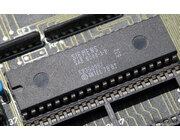Siemens 8088 -1-P
My first PC had this Intel-clone 8088 8MHz processor. Along with 640KB RAM, 5,25" DD drive and a Seagate ST-225 'tank' it found it's home in an ARC ProTurbo-88. The 8088 is a cheaper variant of the 8086. Whereas the 8086 has a 16-bit I/O interface the 8088 has 8-bit. Because of this motherboard manufacturers could build less complex and thus cheaper motherboards.
The 8086 and 8088 CPU's are found in many old PC's. The IBM 8530 had a 8086 for example. Because IBM's policy was to have more than one supplier of chips, other companies like Siemens and AMD started manufacturing these CPU's as well. That's why many of the 8086/8088 clones also have the Intel-copyright marking printed on.
I consider the 8086/8088 as 'the' start of the modern computer. Of course there are other models available with different CPU's (like the Motorola 68000) but the 8086/8088 was (and is actually) the foundation of the CPU's today. CPU's like the 286, 386 and today's Intel Core and AMD Phenom / Opteron systems have something in common. The 8088 / 8086 featured an x86-architecture, just like today's CPU's in desktop PC's and many servers. Thanks to this it's possible to run old MS-DOS versions on the latest systems. Also 'thanks' to this some problems occurred because the 8086 / 8088 had limitations in addressing memory. Only true 32-bit operating systems (not MS-DOS (16-bit), nor Windows '95 but Linux, Windows NT and up) escape this problem.
 R80286 8
R80286 8
